To germinate accurately: how to check seeds before planting

Testing seeds for germination is an important step for any gardener. It allows you to assess the quality of planting material in advance, plan planting, and calculate the optimal number of seeds.
These simple methods will help you test your seeds for germination and take confident steps toward the successful cultivation of your favorite crops. UNIAN offers 3 affordable ways to test seeds for germination.
1. Test in salt water:
- Prepare a solution of 1 teaspoon of salt per 1 liter of water.
- Immerse the seeds in the solution and leave for 2-3 hours.
- Seeds that float up will probably not germinate, and those that sink to the bottom can be used for planting.
2. Check on a wet napkin:
- Take a wet napkin (or wet a regular one).
- Spread the seeds on the napkin, keeping a distance between each seed.
- Cover the container with a lid or film and leave it for a few days.
- Ventilate the seeds daily to avoid mold.
- Sprouted seeds indicate that they are ready for planting.
3. Test in sawdust:
- Lightly moisten sawdust and spread it on the bottom of the container in a 2 cm layer.
- Spread the seeds out, keeping a distance between them.
- Cover the seeds with sawdust and set them aside for germination.
- After a few days, evaluate the result: germinated seeds indicate their viability.
Remember:
- Before testing, it is recommended to calibrate the seeds to select the best specimens.
- Seed germination time may vary for different crops, so it is important to know this information.
- Based on the results of the test, you can adjust the number of seeds you plan to plant.
If you want to get the latest news about the war and events in Ukraine, subscribe to our Telegram channel!
